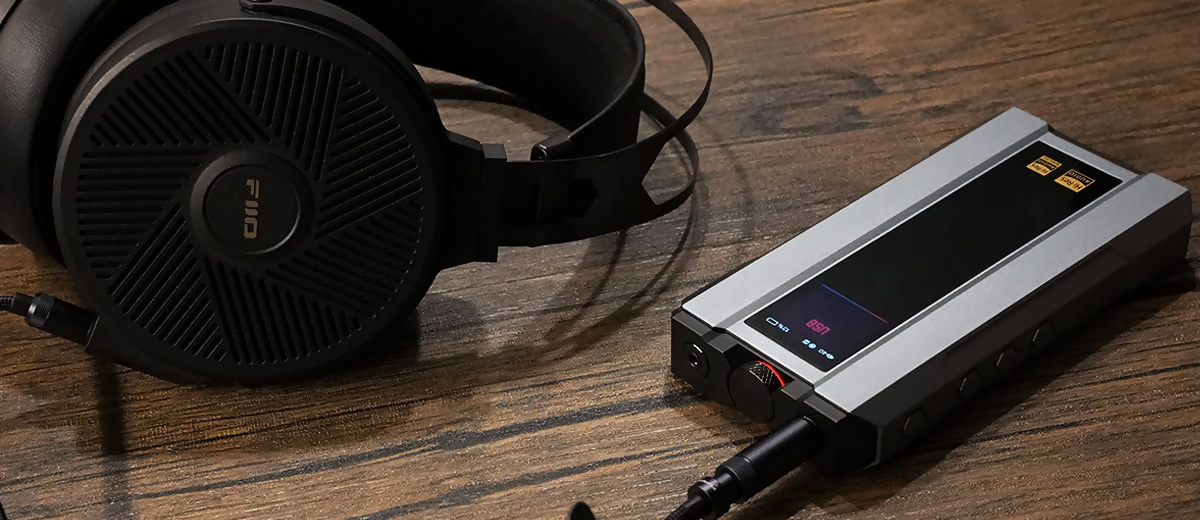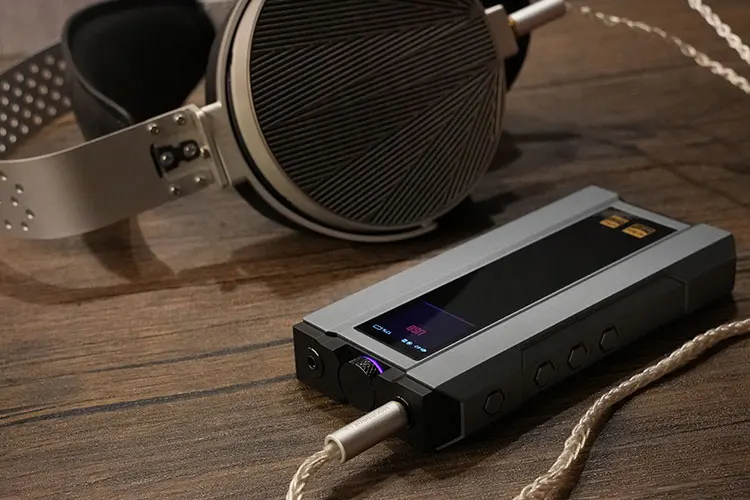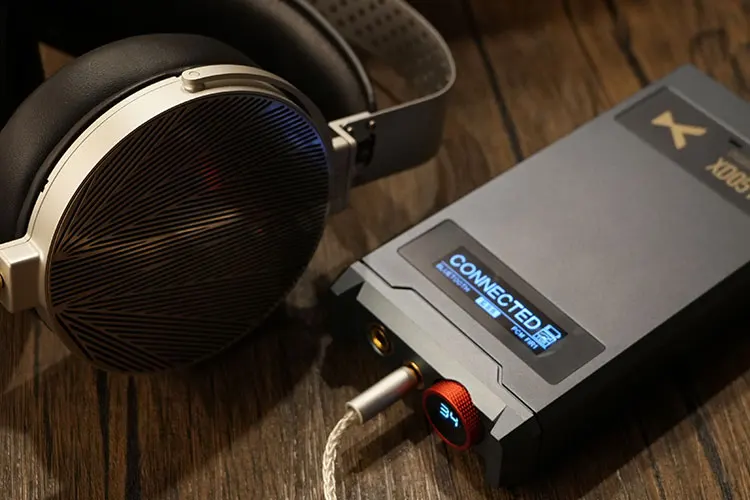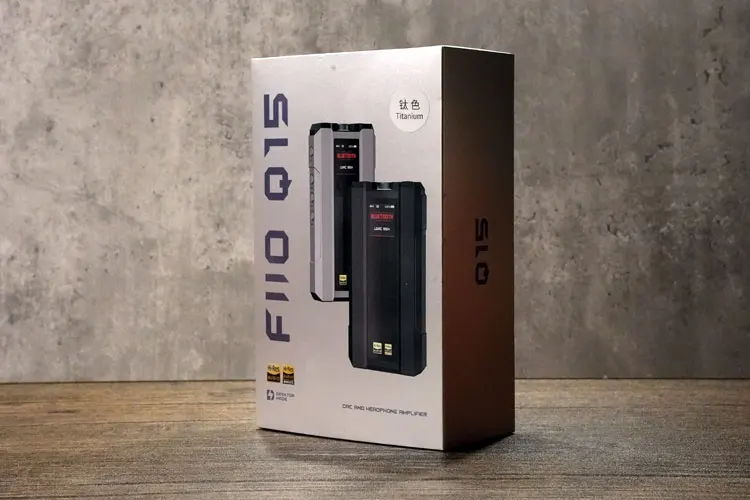Synergy
Power
The Q15 is quite powerful already without a PD power source and when plugged in with external USB PD power you can immediately feel a sense of spaciousness.
While that brings in more treble details to the stage, it doesn’t introduce sibilance and the background noise control remains excellent even at a higher gain, without compromising dynamics.
The lower gain seems to be optimized for IEMs and it is free from noise, with decent punching power in the lows and good openness in the mids when testing with the Westone MACH 30 and the Earsonics Elements.
So, you don’t need to worry this powerful amplifier may sound clinical or too blunt in the upper frequencies.
The Q15’s higher gain boosts the upper mids and treble’s presence, while the lows also sound more solid, which gives the bass a stronger definition on more demanding gear such as the MOONDROP PARA.
Pairings
The Q15 is versatile in handling different loads, even planar cans like the PARA can be driven very nicely to sound dynamic and airy. The Q15 works very well with the FiiO FT5 Planar headphones with a very stereophonic sound and an elaborated vocal range, combined with a clear and solid bass punch.
It may struggle slightly to sound as dynamic when it comes to more demanding gear like the MOONDROP Venus in portable mode. However, when switching to desktop mode you can feel there is better bite and extension in the bass, also the treble sounds swifter.
I would consider the tuning revealing so it is better to pair with IEMs that are more colored or titled towards the lows, or else the treble may come across as sharp.
Connectivity
Bluetooth
FiiO uses the Qualcomm QCC5125 Bluetooth solution which is a common pick for higher-end receivers as it supports high-resolution codecs like LDAC.
I have brought the Q15 outdoors on a train to test and the connection is very stable putting the Q15 in my backpack while moving my source quickly around.
On LDAC connection there are still noticeable lip-sync delays and you may turn to other lossier codecs if you want the audio to be more closely synced with the video played.
USB-DAC
FiiO has selected the XMOS 16-core XU316 USB solution for the Q15, known for its superior clock management capabilities. This USB solution enables the Q15 to support high-resolution audio formats such as 768kHz/32bit PCM, DSD512, and full decoding of MQA.
When connecting the Q15 to your phone, you have the option to switch it to Phone Mode.
This mode ensures that the battery on the Q15 is utilized for power rather than draining the battery of your phone. It also allows for extended listening sessions without worrying about excessive power consumption on your phone.
Select Comparisons
xDuoo XD05 Pro
Technical
The huge XD05 Pro is a very fun unit with swappable modular designs that allow users to change the DAC section as well as the amplification section. It is truly a beast measuring 18.5 x 9.5 x 3.3cm and weighing 0.78kg. It is capable of outputting 2000mW @ 32Ω load and 930mW @ 300Ω load.
I am using the stock card with ESS ES9039s Pro chipsets supporting up to DSD512 decoding with Class A amping.
You may purchase the Rohm BD34301EKV DAC and AKM AK4499ex DAC modules and potentially other amping modules that sound different from the stock module.
Design
The XD05 Pro is roughly 3 times the mass of the Q15 and has quite a lot more I/O options such as AES digital in.
You will notice a similar color theme, though the XD05 has dual screens and a touch of red on the volume knob and on/off button to brush up the design. Whereas the Q15 has contrasting black colors added to the other parts and the overall build quality is more solid.
Performance
The Q15 is emphasized for its output power, especially in desktop mode which is why I am tempted to compare it to the mighty XD05 Pro.
In practice, with small IEMs, it is quite hard to notice a difference in power, and the XD05 Pro sounds more energized in the upper frequencies than the Q15 which renders the mid-lows fuller.
To me, the XD05 Pro feels more expansive though it is not as delicate in delivering details and layering at the two ends of the spectrum as the Q15, which also sounds more organic and unaltered in the tuning when comparing both designs with external power plugged in.
Going wireless, the Q15 displays stronger control and density in the mid-lows, while the XD05 Pro delivers a more V-shaped output and outlines the vocal line clearer, also smoother in the mids.
When testing with more demanding gear like the MOONDROP Venus, the XD05 Pro has an edge and feels more dynamic and textured in the lower end, whereas the Q15 sounds smoother and flatter.
However, I still consider the Q15 to be quite powerful, despite its limitations due to size and power constraints. The balance in the output, as well as the resolution at higher volume, are worth complimenting considering its size versus the goliath.
FiiO Q5S Type-C
Technical
The FiiO Q5S Type-C is a smaller Bluetooth DAC and Amplifier I reviewed a while back. It features THX AAA-78 in the AM3D module amping section, which claims to be the world’s most linear-sounding technology for headphone systems.
The design uses Qualcomm QCC5124 Bluetooth 5.0 chipsets and XMOS XUF208 USB solution which gives it solid performance on a USB connection.
The Q5S is capable of delivering 560mW @32Ω to its balanced output and can power various IEMs effortlessly.
Design
Aside from its fun modular design, the Q5S looks sweet, combining different elements such as brushed aluminum, chamfered edges, and a sand-blasted grey body. It also features a leather insert at the back.
The build quality is solid and techier with physical buttons whereas on the Q15 we can see the toggles such as gain and equalizing options are now made digital, controllable on the app instead.
The design language is quite differentiated as FiiO uses matte glass and a dark glass panel that fits a screen seamlessly on the Q15. Features such as the Phone mode make the design more intuitive and minimalized.
Performance
While the Q5S was released two years ago, it is priced in a similar bracket. I have traveled quite a bit with the Q5S and appreciate its precise and linear sound, particularly with the AM3D module.
However, with the larger Q15, we can observe several upgrades. It delivers even stronger technicalities and sound qualities that the Q5S excels at, such as precision and linearity.
Additionally, it significantly improves output power and distortion control, making it more compatible with headphones and demanding IEMs.
When testing the Q15 with Tidal content streamed via Bluetooth, it can extract more detail, especially in the treble. It captures more air without introducing additional sharpness or sounding flat. The higher output power also allows for deeper headroom and bass, while maintaining responsiveness.
The Q15 has a more colored sound with its fuller mid-lows, whereas the Q5S smoothes out this area, effectively hiding the disadvantage when the power is not as strong.
Overall, the Q15 sounds more defined, and dynamic, whilst still maintaining good balance and openness. I would consider it a comprehensive upgrade for the Q5S though be noted that the size is also nearly 1.5x of the Q5S.
Our Verdict
The FiiO Q15 is an early adopter of the flagship AK4499EX solution, which separates the digital filter and delta-sigma stage from the analog DAC.
Although this deviates from the usual practice, the result is very convincing, delivering a strong transient performance and an airy presentation. The Q15’s capabilities are further enhanced and extended in Desktop mode, and it offers app-controlled PMEQ features.
Overall, the Q15 is highly feature-packed and well-built, and it does not let down in the sound department and noise control is excellent. For those who stream from their phones, the Q15 serves as a portable powerhouse and the strong technicalities allow it to perform well with a wide range of gears.
FiiO Q15 Technical Specifications
- Weight: 305g
- DAC: AK4191EQ+AK4499EX
- USB: XMOS XU316
- Bluetooth decoding: QCC5125
- Display: 1.30-inch TFT (240*240) bezel-less display
- Gain: Ultra High (In Desktop mode, Power in port connected with QC power) /Super High/High/Medium/Low gain mode
- MQA: Supports MQA Full Decoder
- USB DAC: Up to PCM 768kHz/32bit, native DSD512
- Coaxial decoding: Up to PCM 192kHz/24bit, DoP DSD64
- Battery capacity 5500mAh lithium polymer
- Charging time: About 3.5h (PD fast charge)
- SNR (BAL) ≥ 123dB (A-weighted)
- Output impedance (BAL): <1.5Ω
- Peak output voltage (BAL): 29Vp-p
- Output power (BAL): 635mW @16ohm, 1610mW @32ohm, 340mW @300ohm






